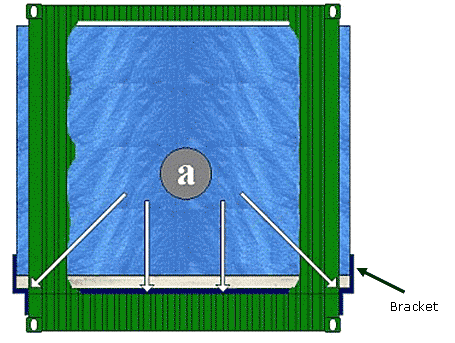12.1 Securing packages (boxes, crates, frame constructions and sleds) Correctly stowing and securing such packages ensures that they survive the transport without damage. It is often difficult to secure loads with large dimensions and gross weights. If, for instance we take a large box or crate containing heavy goods, the package has large, smooth exterior walls which are hardly suitable for attaching load-securing materials. This fact leads to certain demands on the manufacturers of packaging containers to provide additional constructional features that facilitate adequate load securing. It must be noted that not all the components of a package, in particular of a package for heavy goods, is capable of absorbing and maintaining high securing forces. See section 6.6. In the case of the packages listed above, the "floor" assembly is the element that is best able to withstand loads. The topic of securing packaged goods on the various means of transport is a very expensive one. Detailed, freely available information and suggestions on the subject of load securing can be found in the following publications, among others:
12.2 Possible load-securing measures for packages The first load securing measure is to ensure that the coefficient of friction µ between the load and the loading area is as high as possible. The higher the coefficient of friction, the easier all further necessary measures will be. The coefficient of friction is influenced by the material pairings involved and the condition of the materials (rough, smooth, wet, dry). One common technique for achieving a high coefficient of friction is to use an intermediate layer of friction-enhancing mats.
Table 17: Coefficients of friction (sliding friction) for different pairs of materials 
Figure 112: Example of how to secure overwidth packages Figure 112 shows an example of how to secure an overwidth package against slipping on a flat rack. The package is secured using brackets attached to the sides. Further examples can be found in the GDV Container Handbook. There are two fundamental load securing techniques:
These methods are used for all means of transport and can be used in isolation or in combination. The load securing requirements must always be determined or verified by calculations. The transport loads listed in section 1.3 form the basis for the calculation. Information on using the methods can be obtained from: GDV Load Securing Handbook available at www.tis-gdv.de BAM Load Securing Handbook available at www.bam.de under Service, Publikationen, Handbuch Guidelines for Packing of Cargo Transport Units, Document no. B 8087, Verkehrsblatt Verlag, Dortmund |
|||||||||||||||||
| Top of page | Contents |
